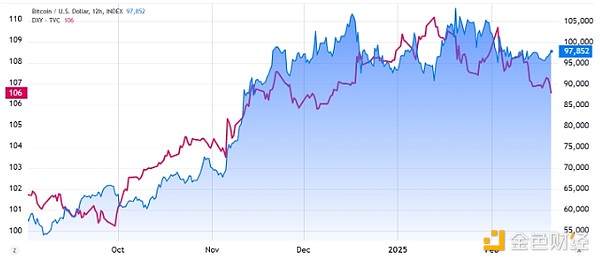Author: Marcel Pechman, CoinTelegraph; Compiler: Baishui, Golden Finance
On February 20, the S&P 500 fell 1%, and the dollar weakened against a basket of foreign currencies, falling to its lowest level in 70 days. Over the past six months, Bitcoin has shown a positive correlation with the US dollar index (DXY), which has led traders to wonder whether a correction is imminent.

DXY Index (left) vs. Bitcoin/USD (right). Source: TradingView / Cointelegraph
While it is difficult to directly link a causal relationship between the US Dollar Index and Bitcoin prices, both rose between September 2024 and January 2025 before facing challenges maintaining bullish momentum.
Some analysts believe that the election of U.S. President Donald Trump has boosted fiscal sentiment, which could lead to a stronger national currency. However, recent data, whether attributed to the previous administration or not, show persistent U.S. inflation and weak retail sales, pointing to the possibility of “stagflation” ahead. It’s too early to assess the full impact of recent import tariffs and government budget cuts, but Larry Adam, chief investment officer at Raymond James, highlighted in a Feb. 14 note that this could have a negative impact of 0.6% on U.S. GDP growth and warned that inflation could rise by 0.5%. While this scenario itself is not bullish for Bitcoin, it could dampen investors’ risk appetite.
DXY Index Pressures Bitcoin Price, But Trend May Weaken
On February 20, U.S. Treasury Secretary Scott Bessant said the government has not yet moved in the direction of issuing more long-term bonds. "That's a long way off," Bessant commented. Despite previous criticism of Janet Yellen's preference for short-term debt, the previous administration's approach remains unchanged.
Bessant explained that any move toward long-term bonds would depend on market conditions and inflation trends, attributing the current situation to "Biden inflation." More worryingly, however, Bessant noted that "it's easier for me to extend maturities when I'm not competing with the Fed," which has been a "big seller" of government bonds.
The positive correlation with the DXY index has exerted downward pressure on Bitcoin's price. However, this trend may weaken as investors shift Bitcoin from a risky asset to a scarce hedge asset similar to "digital gold." Part of the reason for this shift is that several U.S. states have introduced legislation to allow Bitcoin to become a reserve asset.
On February 19, the Montana Business and Labor Committee passed a bill to establish a special revenue account for investment in precious metals and Bitcoin. Other states, including Utah, Arizona, Oklahoma, Illinois, Kentucky, Maryland, New Hampshire, New Mexico, North Dakota, Ohio, Pennsylvania, South Dakota, and Texas, have also introduced Bitcoin reserve bills.
On February 20, the price of Bitcoin broke through $98,000, indicating that investors are increasingly aware of its hawkish monetary policy. This is particularly important given the high risk of an expansionary monetary policy by the U.S. government (for example, if Elon Musk’s Ministry of Government Efficiency achieves its spending-cutting goals).
Investor caution is also reflected in gold prices, as the precious metal hit a new all-time high on February 19. Rather than focusing solely on the dollar’s performance relative to other currencies, traders should focus on how nation states value Bitcoin. Czech National Bank Governor Aleš Michl has stressed the importance of assessing Bitcoin’s potential as a reserve asset.
Ultimately, Bitcoin’s path to new all-time highs depends largely on inflows into spot Bitcoin exchange-traded funds (ETFs), the preferred vehicle for institutional investors — which has not been the case over the past two days, with cumulative net outflows of $125 million, according to Farside Investors.
 Weatherly
Weatherly





